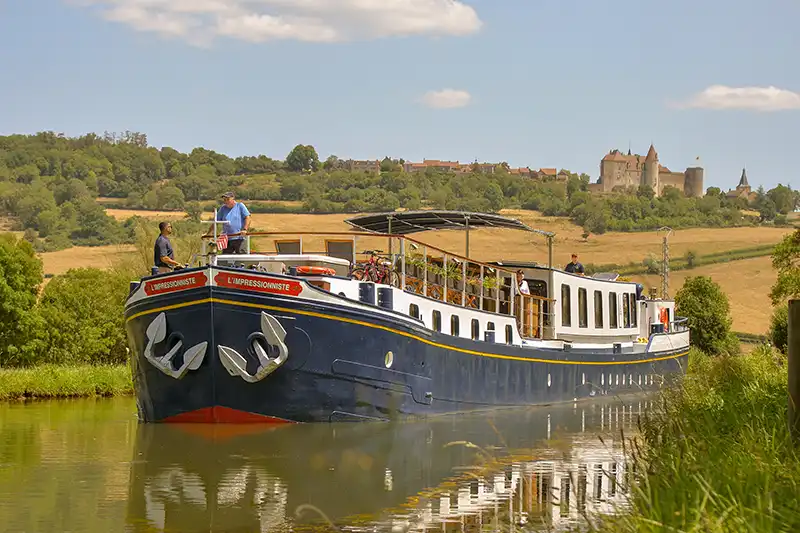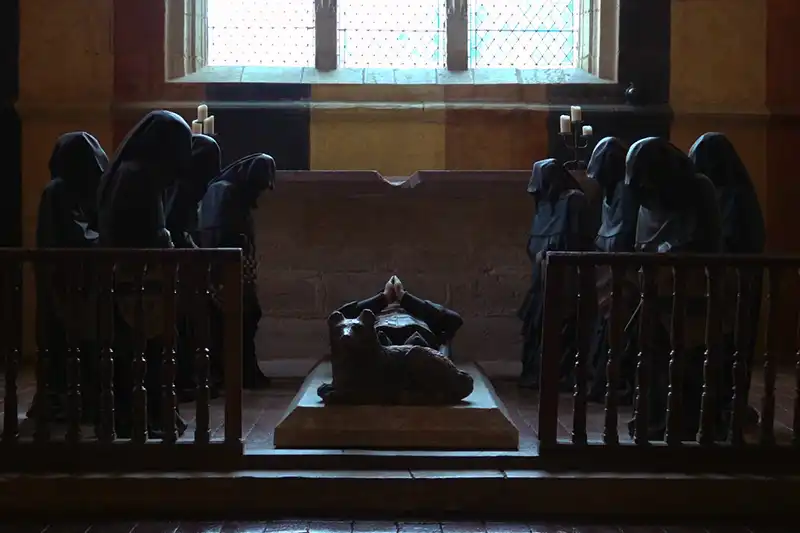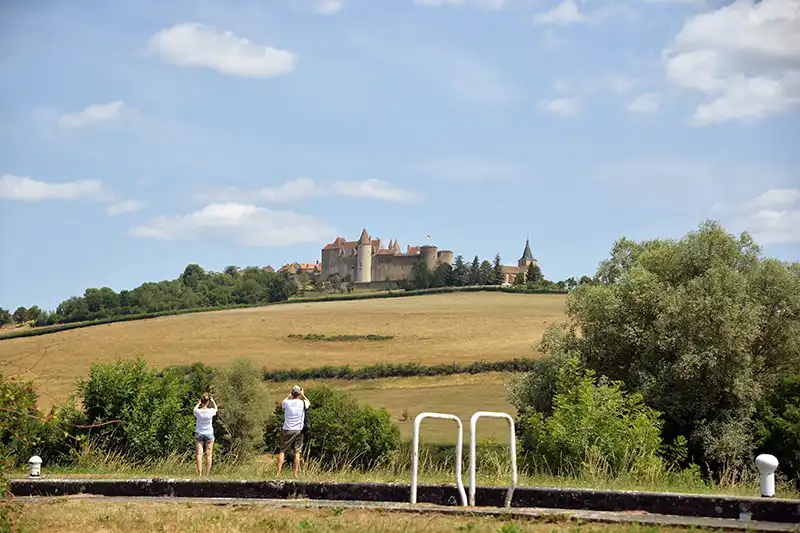Have you ever wanted to visit a fairytale-like castle? Cruise the Burgundy Canal aboard hotel barge L’Impressionniste and you will be greeted with this amazing sight. Up on a promontory, overlooking the canal sits just such a castle at Châteauneuf-en-Auxois.
Châteauneuf-en-Auxois: Home of a Fairy Tale Castle in France

A Very Old ‘New Castle’
Châteauneuf means ‘new castle’. And this was once a new castle, back in the 1100s! The land was given by the Lord of Chaudenay to his second son, Jean who went on in the later part of the 12th century to build himself a fortress with an all-encompassing view and declared himself ‘Jean I of Châteauneuf’.
The castle itself showcases many centuries and periods of building styles and as you enter over its drawbridge you can see buildings ranging from the 12th through to the 17th centuries. Rather like adding on an extension to our own homes, this castle experienced something similar, but on a much larger scale. Today it is very much an educational tool in castle building history.
Room for Improvement
Essentially there were three important stages in the castle development. The original 12th century square tower built by the sons of Jean I (Jean II, and Jean III) still stands. In the 15th century, Philippe Pot – diplomat and godson to Philip the Good, Duke of Burgundy – was given the castle and all the decorative elements that you can see today. Gothic in style, the masonry work is stunningly detailed.
A copy of Philippe Pot’s effigy can be seen in the chapel. He designed it himself and decided that no matter what, his family should be seen to mourn him. The hooded figures that surround him represent various branches of the family, denoted by the heraldic shields they hold. The original effigy now resides in the famed Louvre Museum in Paris.

A Tale of Murder
Of course, a story about a fairy tale castle would not be complete without mayhem and murder and here, such a drama triggered the loss of Chateauneuf by Jean 1’s family Jean Is family ownership of Châteauneuf after nine generations and its acquisition by Philippe Pot.
In the mid-1400s, Catherine, the lady of the household, who some suspected of already killing her first husband, poisoned her second husband Jacques d’Haussonville. She was only caught because a servant ate some of Jacque’s meal and sadly the servant also died, throwing suspicion and ultimately a guilty verdict on to Catherine. The castle was consequently confiscated by the Duke of Burgundy and given to Philippe Pot.
From Renaissance to Revolution
In the 17th century, the Vienne family purchased the castle and adorned it with Renaissance styled interiors. Plush in colour and textiles, it showed off their wealth and power, particularly as this was only their weekend home. Their main home was Château de Commarin, a short distance further up the valley. The family’s descendants owned the castle until just prior to World War Two.
However, the French Revolution in 1789 destroyed the opulence of the château. Many artworks, statues and heraldic symbols were ruined or defaced. The results of this ransacking can still be seen at the château today, with mock-ups to show what they looked like before.
Châteauneuf-en-Auxois in Ruins
The castle never quite returned to its former glory after this, and in 1936 was gifted to the French government by the owning Vogüé family to be then declared as a national monument. However, World War Two and the accompanying occupation did nothing to aid the care of this fairy tale castle.
Fast forward to 2018, when the castle was handed over to the regional government that the ruinous trend is reversed. Now considered a time capsule of architecture, the castle is slowly being restored using traditional methods and you can watch its history unfold as you walk through its rooms and courtyards.

Beyond the Fairy Tale
There is an old Roman road leading from the castle village and promontory into the woods on the ridge. About half a mile into the trees there are the ruins of the old hermitage of Saint-Julien. A chapel was built here in the 13th century, originally to house two hermits. Over time it grew and was used as a leper colony and then hospice for plague victims.
In the 20th century, the chapel slowly began to fall to ruin. After World War Two decay truly set in, and it now has become a romantic ruin being swallowed up by the forest that surrounds it.
The Medieval Village
A small medieval village sits behind the castle walls, with narrow streets and cobbled alleyways connecting them. Have a wander about to see merchant’s houses with towered staircases, and beautiful flowers climbing up walls whilst glimpsing intricate detailing and amazing views between the buildings.
At the top of the village, through the north gate there is a walkway past walled gardens. It brings you to a panoramic viewpoint looking down over the canal. The various reservoirs that feed the canal can be seen dotted across the countryside. with the pretty village of Pouilly-en-Auxois, the highest point on the Burgundy Canal, visible in the distance.
An Artist’s Dream
The village itself is currently home to about 90 people, a good portion of whom are artists and artisans. Art galleries delight the senses, filled with everything from large wooden animal sculptures to vista paintings, snail inspired jewellery and castle-inspired treasures for visitors to take home as souvenirs.
There is also an assortment of cafés, bars and restaurants to enjoy a little coffee or maybe indulge an ice cream set amongst the ancient buildings. All give a chance to peek inside these beautiful medieval houses.

What’s in a Name?
Did you know that, as well as meaning ‘castle’, the French word ‘château’ also means manor house, or fortified farm or even a “real” chateau? Unlike in English, in French there is only one word really used for any such large residence.
You may be familiar with Châteauneuf-de-pape. This region makes a very well-known wine which you can enjoy whilst cruising with European Waterways but should not (but can) be confused with Châteauneuf-en-Auxois, a very different place whose name means ‘New castle on the river Auxois’. The name Châteauneuf-de-pape means the ’Pope’s new castle’ (and is a whole other story for another time).
Visit Châteauneuf-en-Auxois aboard L'Impressionniste
A visit to the medieval village, craft shops and castle of Châteauneuf-en-Auxois is a true highlight on a week-long cruise aboard hotel barge L’Impressionniste. To browse the full itinerary, click here.
Did you know, Châteauneuf-en-Auxois is listed as one of ‘Les Plus Beaux Villages de France‘ or ‘One of the Most Beautiful Villages in France’? This collective promotes French rural villages for tourism, based on their cultural heritage and integration into the landscapes that surround them. In other words, it’s beauty is award-winning!
Get in touch: If you’d like us to send you a complimentary copy of our brochure, please fill in the following form, or speak to a member of our cruise team via our contact form.


 English
English
 Spanish
Spanish French
French German
German Norwegian
Norwegian Portuguese
Portuguese Swedish
Swedish Italian
Italian Russian
Russian Simplified Chinese
Simplified Chinese Japanese
Japanese